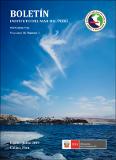Por favor, use este identificador para citar o enlazar este ítem:
https://hdl.handle.net/20.500.12958/3356| Título : | Aspectos biológico pesqueros de Carangoides otrynter (Jordan & Gilbert, 1883) especie no nativa de Perú. Pacasmayo, 2016 |
| Otros títulos : | Biological and fisheries aspects of Carangoides otrynter (Jordan & Gilbert, 1883) a non native species of Peru. Pacasmayo, 2016 |
| Autor : | Goicochea Vigo, Carlos Atoche Suclupe, Dennis Paredes Paredes, Jacinto Vásquez Ruiz, Cinthia |
| Palabras clave : | Carangoides otrynter;Aspectos biológicos;Mugil cephalus;Paralonchurus peruanus;Sciaena deliciosa;Ethmidium maculatum;Anisotremus scapularis;Oplegnathus insignis;región La Libertad |
| Fecha de publicación : | 2019 |
| Editorial : | Instituto del Mar del Perú |
| Citación : | Bol Inst Mar Perú. 34(1) 2019: p.128-134 |
| Citación : | Boletín IMARPE;34(1), 2019 |
| Resumen : | Se determinaron algunos aspectos de la biología de individuos de Carangoides otrynter recolectados de los desembarques de la pesca artesanal en Puerto Pacasmayo los días 13 y 22 de febrero 2016. Se determinó estructura por tallas, madurez gonadal microscópica, contenido estomacal y edad. La captura se realizó con redes tipo cortina de 76,2 mm y 88,9 mm de cocada, a profundidades de 5,5 a 14,6 m en El Loro, Dos Cabezas, El Faro, Santa Elena, Puémape, El Milagro y Chérrepe, que se caracterizan por tener fondos pedregosofangosos. Esta especie fue capturada como fauna acompañante de peces costeros como Mugil cephalus, Paralonchurus peruanus, Sciaena deliciosa, Ethmidium maculatum, Anisotremus scapularis y Oplegnathus insignis. La talla de C. otrynter varió de 23 a 29 cm de longitud total, moda 26 cm y longitud media de 26,5 cm. Laproporción sexual fue estadísticamente igual en hembras y machos. Los ovarios estuvieron 100% virginales y los testículos 80% maduros y 20% en maduración. La única presa fue anchoveta, con longitud total que varió de 81 a 105 mm. La edad de C. otrynter correspondió a individuos menores a 1 año. Se concluye que los individuos de esta especie, no oriunda del mar peruano, son juveniles inmaduros entre 6 y 8 meses de edad, cuyo hábitat está relacionado a fondos rocoso-fangosos; no obstante, su alimentación está orientada al recurso anchoveta.
Palabras clave: Carangoides otrynter, aspectos biológicos, región La Libertad ABSTRACT: Some biology aspects of Carangoides otrynter, which were collected from artisanal fishing landings in Puerto Pacasmayo on 13 and 22 February 2016, were determined. The structure was defined by size, microscopic gonadal maturity, stomach content, and age. The catch was made with curtain nets of 76.2 mm and 88.9 mm of mesh size, at depths of 5.5 to 14.6 m in El Loro, Dos Cabezas, El Faro, Santa Elena, Puémape, El Milagro, and Chérrepe, which are characterized by having rocky-muddy bottoms. This species was caught as an accompanying fauna for other coastal fish such as Mugil cephalus, Paralonchurus peruanus, Sciaena deliciosa, Ethmidium maculatum, Anisotremus scapularis, and Oplegnathus insignis. The size of C. otrynter ranged from 23 to 29 cm in total length, mode was 26 cm, and mean length was 26.5 cm. The sex ratio was statistically equal in females and males. The ovaries were 100% virgin and the testicles were 80% mature and 20% at maturation. Anchoveta was the only prey, with total length ranging from 81 to 105 mm. The age of C. otrynter corresponded to individuals less than 1-year-old. We conclude that the individuals of this species, which is not native to the Peruvian sea, are immature juveniles between 6 and 8 months of age, whose habitat is related to rocky-muddy bottoms; nevertheless, their diet is oriented to the anchoveta resource. Keywords: Carangoides otrynter, biological aspects, La Libertad region |
| URI : | https://hdl.handle.net/20.500.12958/3356 |
| ISSN : | 03787702 |
| Aparece en las colecciones: | Boletín 34(1), 2019 |
Ficheros en este ítem:
| Fichero | Descripción | Tamaño | Formato | |
|---|---|---|---|---|
| Boletin 34(1)-11.pdf | 1,22 MB | Adobe PDF |  Visualizar/Abrir |
Este ítem está sujeto a una licencia Creative Commons Licencia Creative Commons

